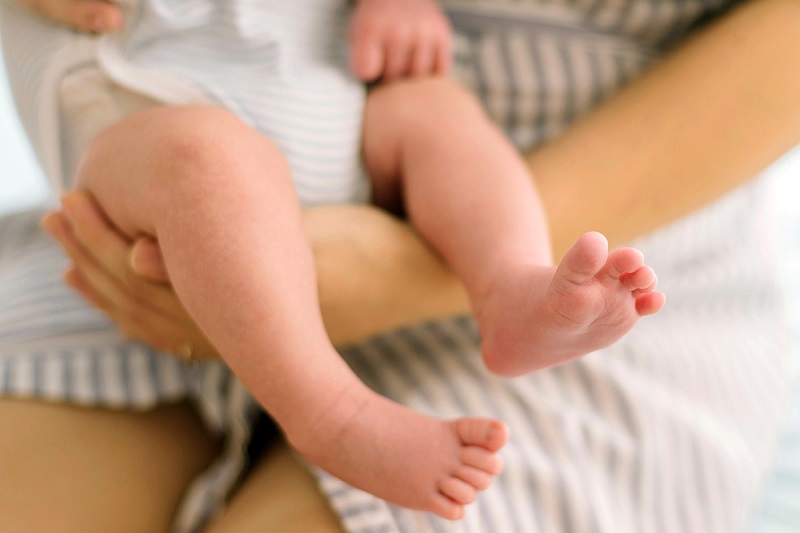Parents are often a bit freaked out when I examine a baby’s hips during their well visits. It’s not the most comfortable part of the exam for a baby, and sometimes they cry out as I lie them on their back and rotate their hips outwardly, but it is important as I’m trying to identify early signs of hip dysplasia, a relatively common finding that can have long-term consequences if not identified and addressed.
If you’re a new parent, you’ve probably heard about hip dysplasia from reading about proper hip alignment in the instruction manual of a new baby carrier or when learning about swaddling. There are a lot of panic headlines about it, but what does it actually mean? And what can be done about it?

Hip dysplasia is a general term for when the hip joint doesn’t develop normally. A small proportion of hip dysplasia cases are caused by connective tissue or genetic issues that affect the baby’s ligaments more globally, but most cases occur in otherwise healthy babies, which is the type I discuss below.
Despite hip dysplasia being a relatively common condition that all pediatricians will see in their practice, there remains a lot that is unknown or controversial. I’ll try to outline what we know and what we don’t, and what parents can do to try to prevent it.
Why does hip dysplasia happen?
To understand how hip dysplasia can occur, we first need to understand the hip joint a bit.
The hip joint is a “ball and socket” joint where the femoral head (the top of the femur bone) acts as the ball and the acetabulum (a concave depression) of the pelvic bone serves as the socket. Like other joints, ligaments hold the bones in contact and in the proper relationship to each other. The proper positioning of these bones is critical for allowing the bones to shape properly during the first year of life.
Babies are naturally born with relatively loose ligaments around their hips. You may notice how flexible they are in moving their hips, but in the next few weeks these ligaments should tighten and hold the femoral hip nicely in the developing socket of the acetabulum.
How is hip dysplasia diagnosed?
When physicians examine babies’ hips, they are looking for two concerning behaviors: subluxation or dislocation. Subluxation is when the femoral head sits partially outside the hip socket, and dislocation is when it sits fully out of the socket. Some hips will subluxate or dislocate on exam but slip back into position when left at rest, while others will stay in those subluxated or dislocated states. Finding hips that can be subluxated or dislocated during the exam, or that are subluxated or dislocated at rest, would be an indication for further testing and treatment.
Pediatricians will also look for leg length and butt crease asymmetries, which could be indicative of a femoral dislocation. If you think you notice an asymmetry in your child’s legs or buttocks, you should let your pediatrician know. If your pediatrician suspects a dislocation or subluxation, the next step is to do imaging, generally with an ultrasound.
How common is hip dysplasia?
Surprisingly, even the incidence of hip dysplasia is unclear, and that’s for two reasons.
First, there is a natural resolution of early hip laxity in many infants, so when you measure it, it will lead to inconsistent results. Perhaps more importantly, there’s no agreed-upon definition of what qualifies as hip dysplasia, whether that is by physical exam or by imaging studies, so different studies over time have relied on different definitions.
Having said that, hip dysplasia occurs in somewhere between 0.5% and 3% of all infants, but nearly 40% of newborns will have at least some mild hip laxity. Using ultrasound, a prospective study found that 5.5% of newborns met the criteria for hip dysplasia, but when the exam was repeated two to six weeks later, those findings had resolved for 90% of them. This is why in high-risk babies without worrisome exams, we wait until four to six weeks of life to do an ultrasound, to allow those cases that can self-resolve to do so.
What are the risk factors?
There are four clear risk factors, although the strength of those risk factors varies from study to study. Unfortunately, only one of the risk factors do we have any significant control over.
- Gender: Girls are up to seven times as likely to develop hip dysplasia as boys. No one is 100% sure why this is, but researchers have hypothesized that it is related to a greater influence of the hormone relaxin in females.
- Family history: Genetics is absolutely a factor — 40% of patients with an affected identical twin will have hip dysplasia, while only 3% of patients with an affected non-identical twin will, demonstrating the power of shared genes.
- Breech position: Breech position in the third trimester is associated with approximately four times the risk compared with babies with their heads down. Some studies show reduced risk for these patients if they are manipulated back to head-down and also if they are delivered by C-section. The amplitude of this decreased risk varies by study, and there are no guidelines that recommend manipulation or C-section for this reason.
- “Traditional” swaddling: Some societies have had swaddling traditions that held the babies’ legs together and straight. In these groups, high levels of hip dysplasia have been observed. Notably, hip dysplasia rates dropped in Navajo communities with the introduction of diapers, which kept their legs in a more flexed and externally rotated position. An even more remarkable decrease took place in Japan after a public campaign in 1975 to change swaddling techniques, which lowered the rates of hip dislocation (severe form of dysplasia) from about 2% to 0.2%. This strongly suggests that early leg positioning is a modifiable risk factor for hip dysplasia.
Knowing that swaddling has been associated with hip dysplasia leads some parents to be anxious about swaddling their baby, but it’s clear that it’s the type of swaddling that matters. The safe position for hip development is for the hips to be open and the baby’s legs spread gently open in a frog-leg position. The concerning position is for the legs to be straight down. What we don’t know is how much time is needed to put a baby at risk and the risk of all the intermediate positions.
A reasonable recommendation is to make sure that the baby’s hips can lie comfortably open in any position they remain in for extended periods of time. This can be done with a blanket, a baby carrier, a car seat, and most swaddles. If you want to know specific products that are considered hip-safe, the International Hip Dysplasia Institute has a list (along with a lot of other great resources) on its website. You’ll notice there are products from all the most popular brands.
How is hip dysplasia detected?
Pediatricians and family doctors will screen your baby both by exam and by risk factors and then decide whether to send them to an orthopedist for ultrasound and possible bracing. Given all of what I said above, you’d think screening wasn’t controversial, but it is.
The U.S. Preventive Services Task Force concluded in 2006 that there was insufficient evidence to recommend universal screening for hip dysplasia and has since declined to update its recommendation. Medical societies disagree.
The American Academy of Pediatrics and the American Academy of Orthopedic Surgeons have both published guidelines that support screening. This is based on significant evidence that screening and early treatment can increase the percentage of babies whose ultrasounds and exams normalize. What’s less clear, but reasonable to infer, is that this will decrease the number of older teenagers and adults with sequelae (subsequent conditions) from hip dysplasia. This sequelae can be quite serious, from poor running mechanics to chronic pain to needing hip replacements at an early age.
All babies should have their hips examined at each well-child visit until they can walk. “High-risk” infants — generally defined as those with a first-degree relative with hip dysplasia requiring treatment, being breech in the third trimester of pregnancy, or known extended leg swaddling — should also have an ultrasound screen at four to six weeks of age.
What’s the treatment for hip dysplasia?
If an abnormality is found during screening, a referral is made to a pediatric orthopedic specialist, who will help determine whether treatment is needed or watchful observation is appropriate.
The goal of treatment is to get hips back into the appropriate position, with the belief that this will lower the risk of a patient developing pain and functional deficits when they are older. Unfortunately, there is not great experimental evidence on how effective short-term treatment affects the long-term health of the hip joint.
The first line of treatment is an external harness that holds the hip in an open position to allow the femoral head to move into the appropriate position in the acetabulum. In the U.S., we tend to use the Pavlik harness. There are no randomized trials for comparison of the effectiveness of different treatment modalities, but the Pavlik harness has several observational studies that show patients with high rates of resolution of clinical and ultrasound findings and a lower risk of complications than is found with other treatment modalities.
One treatment that has been used in the past, which has been found to be ineffective, is double or triple diapering. Though far superior to “traditional” swaddling, diapering does not show evidence of reversing dysplasia better than no treatment.
The bottom line
- Hip dysplasia is a common newborn condition that can lead to lifelong issues with hip pain and function. Pediatricians will screen for it by using an exam and, in high-risk cases, ultrasound.
- Parents can help lower the risk of their baby having hip dysplasia by keeping the hips in an open frog-leg position when positioned for long periods of time.















Log in
This is so concise, clear, and helpful. Thank you.